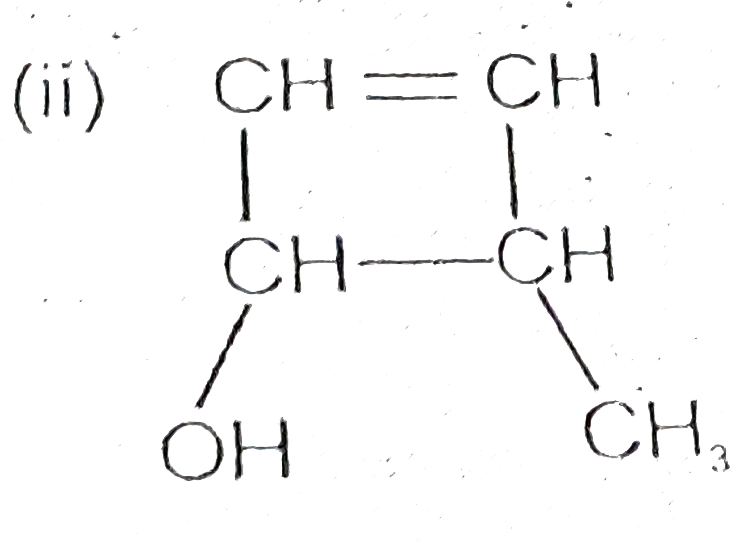Which of the following pairs is expected to exhibit H-bonding
(a) CH3CH2OH and CH3OCH3
(b) CH3NH2 and CH3SH
(c ) CH3OH and (CH3)3N .
To determine which of the given pairs is expected to exhibit hydrogen bonding, we need to analyze each pair based on the presence of hydrogen atoms bonded to highly electronegative atoms (such as nitrogen, oxygen, or fluorine) and the size of these atoms.
1. Understanding Hydrogen Bonding:
- Hydrogen bonding occurs when a hydrogen atom is covalently bonded to a highly electronegative atom (N, O, or F). The electronegative atom attracts the shared electrons, creating a dipole moment where the hydrogen atom becomes slightly positive and the electronegative atom becomes slightly negative.
2. Analyzing the First Pair: CH3CH2OH and CH3OCH3:
- CH3CH2OH (Ethanol) has an -OH group, where hydrogen is bonded to oxygen (highly electronegative). Therefore, it can form hydrogen bonds.
- CH3OCH3 (Dimethyl ether) has oxygen, but the hydrogen atoms are bonded to carbon, which is not electronegative enough to form hydrogen bonds.
- Conclusion: CH3CH2OH exhibits hydrogen bonding, while CH3OCH3 does not.
3. Analyzing the Second Pair: CH3NH2 and CH3SH:
- CH3NH2 (Methylamine) has a nitrogen atom bonded to hydrogen. Nitrogen is electronegative and can form hydrogen bonds.
- CH3SH (Methyl sulfide) has a sulfur atom bonded to hydrogen. Sulfur is less electronegative than nitrogen and larger in size, making it less capable of forming hydrogen bonds.
- Conclusion: CH3NH2 exhibits hydrogen bonding, while CH3SH does not.
4. Analyzing the Third Pair: CH3OH and (CH3)3N:
- CH3OH (Methanol) has an -OH group, where hydrogen is bonded to oxygen, allowing it to form hydrogen bonds.
- (CH3)3N (Trimethylamine) has nitrogen bonded to carbon, but it does not have hydrogen directly bonded to nitrogen in a way that allows for hydrogen bonding with other molecules.
- Conclusion: CH3OH exhibits hydrogen bonding, while (CH3)3N does not.
Final Summary:
- From the analysis:
- Pair (a): CH3CH2OH exhibits hydrogen bonding; CH3OCH3 does not.
- Pair (b): CH3NH2 exhibits hydrogen bonding; CH3SH does not.
- Pair (c): CH3OH exhibits hydrogen bonding; (CH3)3N does not.
Answer:
The pairs that exhibit hydrogen bonding are:
- CH3CH2OH (from pair a)
- CH3NH2 (from pair b)
- CH3OH (from pair c)
- Hydrogen bonding occurs when a hydrogen atom is covalently bonded to a highly electronegative atom (N, O, or F). The electronegative atom attracts the shared electrons, creating a dipole moment where the hydrogen atom becomes slightly positive and the electronegative atom becomes slightly negative.
- CH3CH2OH (Ethanol) has an -OH group, where hydrogen is bonded to oxygen (highly electronegative). Therefore, it can form hydrogen bonds.
- CH3OCH3 (Dimethyl ether) has oxygen, but the hydrogen atoms are bonded to carbon, which is not electronegative enough to form hydrogen bonds.
- Conclusion: CH3CH2OH exhibits hydrogen bonding, while CH3OCH3 does not.
- CH3NH2 (Methylamine) has a nitrogen atom bonded to hydrogen. Nitrogen is electronegative and can form hydrogen bonds.
- CH3SH (Methyl sulfide) has a sulfur atom bonded to hydrogen. Sulfur is less electronegative than nitrogen and larger in size, making it less capable of forming hydrogen bonds.
- Conclusion: CH3NH2 exhibits hydrogen bonding, while CH3SH does not.
- CH3OH (Methanol) has an -OH group, where hydrogen is bonded to oxygen, allowing it to form hydrogen bonds.
- (CH3)3N (Trimethylamine) has nitrogen bonded to carbon, but it does not have hydrogen directly bonded to nitrogen in a way that allows for hydrogen bonding with other molecules.
- Conclusion: CH3OH exhibits hydrogen bonding, while (CH3)3N does not.
- From the analysis:
- Pair (a): CH3CH2OH exhibits hydrogen bonding; CH3OCH3 does not.
- Pair (b): CH3NH2 exhibits hydrogen bonding; CH3SH does not.
- Pair (c): CH3OH exhibits hydrogen bonding; (CH3)3N does not.
The pairs that exhibit hydrogen bonding are:
- CH3CH2OH (from pair a)
- CH3NH2 (from pair b)
- CH3OH (from pair c)
Topper's Solved these Questions
- CHEMICAL BONDING AND MOLECULAR STRUCTUREBOOK - CENGAGE CHEMISTRY ENGLISHCHAPTER - CHEMICAL BONDING AND MOLECULAR STRUCTUREEXERCISE - Exercises Linked Comprehension
43 Videos
- CHEMICAL BONDING AND MOLECULAR STRUCTUREBOOK - CENGAGE CHEMISTRY ENGLISHCHAPTER - CHEMICAL BONDING AND MOLECULAR STRUCTUREEXERCISE - Exercises Multiple Correct(Chemical Bonding )
7 Videos
- CHEMICAL BONDING AND MOLECULAR STRUCTUREBOOK - CENGAGE CHEMISTRY ENGLISHCHAPTER - CHEMICAL BONDING AND MOLECULAR STRUCTUREEXERCISE - Ex 2 .2 Subjective (Molecular Orbital Theory)
4 Videos
- ATOMIC STRUCTUREBOOK - CENGAGE CHEMISTRY ENGLISHCHAPTER - ATOMIC STRUCTUREEXERCISE - Concept Applicationexercise(4.3)
19 Videos
- CHEMICAL EQUILIBRIUMBOOK - CENGAGE CHEMISTRY ENGLISHCHAPTER - CHEMICAL EQUILIBRIUMEXERCISE - Subjective type
1 Videos
Similar Questions
Which of the following parameteres would be expected to have the same values for C2H5OH and CH3OCH3?
View SolutionCH3−CH2=N=OandCH3−CH=N−OH are:
View SolutionArrange the following compounds in increasing order of their boiling points.
CH3CHO,CH3CH2OH,CH3OCH3,CH3CH2CH3
View SolutionWhich of the following will have higher boiling point and why?
CH3NH2orCH3OH
View SolutionWhich isomerism is shown by the following pairs ?
CH3CH2CH2OHandCH3CH2OCH3
View SolutionName the isomerism displayed by the two pairs of compounds:
CH3CH2OHandCH3OCH3
View SolutionWhich is the correct order of increasing basicity?
(A) CH3CH2CH3<CH3CH2SH<CH3CH2OH< CH3CH2NH2
(B)CH3CH2CH3<CH3CH2OH<CH3CH2SH< CH3CH2NH2
(C) CH3CH2NH2<CH3CH2SH<CH3CH2OH< CH3CH2CH3
(D)CH3CH2CH3<CH3CH2OH<CH3CH2NH2< CH3CH2SH
View SolutionArrange the compounds A to D which have roughly the same molecular weight in order of decreasing boiling points.
(A) CH3CH2CH(OH)CH2CH2CH3
(B) CH3(CH2)5CH3
(C ) CH3CH2C(OH)(CH3)2
(D) CH3(CH2)5OH
View SolutionWrite its bond line formula
(i) CH3CH(OH)CH2CH2OH
View SolutionArrange the following compounds in the increasing order of their boiling points:
CH3CH2CH2CHO,CH3CH2CH2CH2OH,H5C2−O−C2H5,CH3CH2CH2CH3
View Solution
